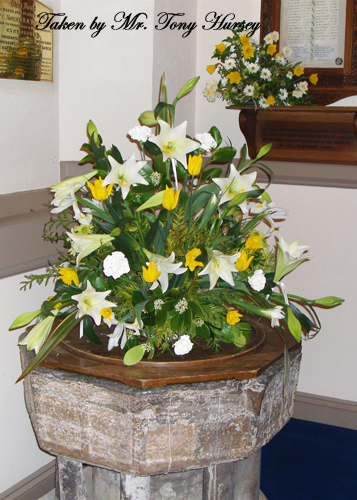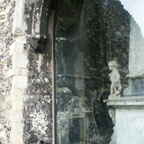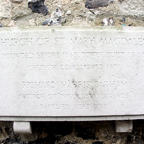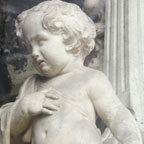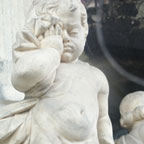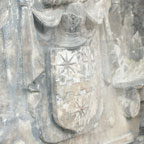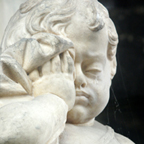
![]()
~ ST. MARY MAGDALEN CHURCH ~
BURGATE STREET, CANTERBURY
Only the Tower Remains
St. Mary Magdalen Parish Records available at the Canterbury Cathedral Archives (1634-1869)
The names of them that were crystened marryed and buryed in the paryshe of Saynt Mary Magdalene in Canterbury, 1890 J. M. Cowper
The church was built in the Norman period and the tower in 1503.
The last service held in the church was in 1866, and the church was demolished in 1871, with the exception of the tower.
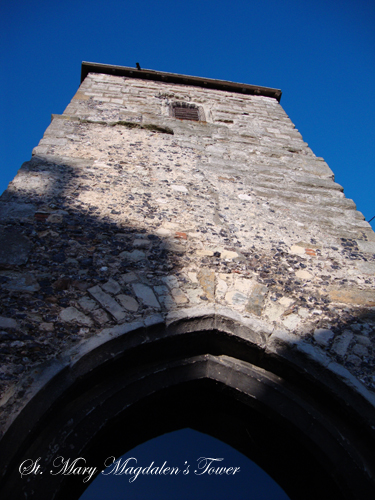
St. Mary Magdalen's Tower built in 1503, you can just see the line of where the church itself attached to the tower
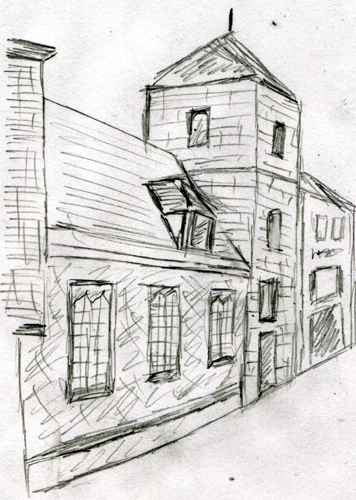 __
__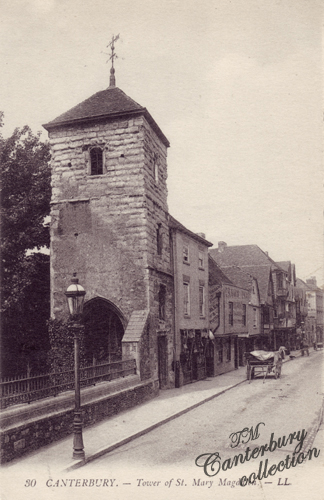
My drawing of St. Mary Magdalen and an old postcard in my collection
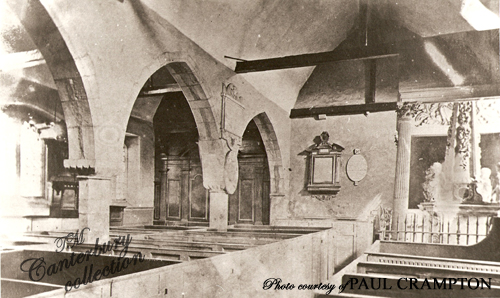
"The interior of St. Mary Magdalene looking west, c.1870. the base of the surviving tower is to the right." Paul Crampton
photo courtesy of Paul Crampton www.paulcramptonbooks.co.uk/
"August 13, 1870. St. George's Church, Canterbury - The legal notice that a faculty has been applied for to close St. Mary Magdalen Church and enlarge that of St. George the Martyr, has been affixed to the church doors in Canterbury. It is propsed to take down Burgate Church, excepting the tower, in which will be preserved the monuments now in the church. The organ, bells and fittings of the church will be sold, and the proceeds given to the fund for enlarging St. George's Church. A part of the St. George's recotry house will have to be pulled down to make room for the new aisle."
The Church of St. Mary Magdalen, in Burgate Street, has the same incumbent as St. George's, and one sexton keeps the keys of both churches. This church formerly belonged to St. Augustine's. There are a nave and south aisle of nearly equal sizes, divided by square columns. Some of the windows may be classed as "perpendicular," whilst others are of the commonest household sort.
The photograph above was taken by Mr. Tony Hursey
The old norman font of St. Mary Magdalen is at St. Peter and St. Pauls Church, River, near Dover, it was purchased by the Rev'd Charles Morice BD in 1875.
I'd like to say a special "thank you" to the Reverend of the River Vicarage for his wonderful help.
The old Norman font, which is octangular, supported by a central column, remains but like most others in the city, has a Wedgewood basin inside. It has been soaked with paint; which indeed, has spread itself all over the church in strange incongruous medley. The pews are of a light lavender colour, reminding you of a Quaker's meeting-house; whilst the altar, with its bad imitations of marble, seems to have been brought from a theatre, where it had served as part of a heathen temple. Two or three imperfect brasses remain. But the most ostentatious feature of the church is the family monument of the Whitfields, compared with which everything in the church, whether for God's use or man's convenience, sinks into insignificance. It stands in meretricious display in the south aisle with its four punchy cupids or angels and pyramid over which is a huge canopy held up by Corinthian columns. There is nothing very remarkable in the exterior. The church has a square tower or steeple, which was built in the year 1503, when probably some of the present windows were inserted. The endowment is much anterior to this time. Towards the building of the steeple, one Sir Harry Ramsay gave six seams of lime. It was to the joint contributions of each, according to his means, that we owe the glorious ecclesiastical buildings which time and the hand of the spoiler have yet spared us. One grave stone, another one, another stained glass, and so on: where is the spirit to do this now-a-days?
Felix Summerly's Handbook for the City of Canterbury 1843
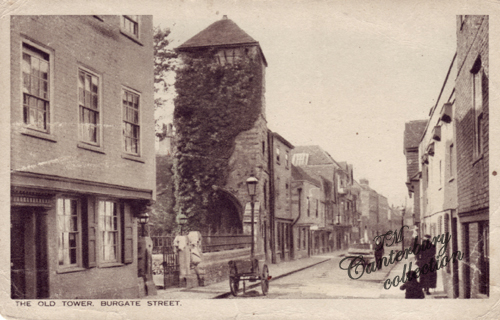
1838
Patrons, The Dean and Chapter of Canterbury
Incumbent & Rector - Frederick ROUCH, Green Court
Churchwardens:
W. SHARP, Burgate Street
G. KIRBY, Canterbury Lane
Parish Clerk, Richard WELLARD, Burgate Street
Sexton, Thomas GEORGE, Canterbury Lane
City grants lands and tenements within City Wall from Burgate towards Northgate. Cathedral to repair the City Wall here. Prior and Convent to have liberty to make a postern and bridge between churches of Northgate and Burgate. 1737-1780 CCA-CC-SuppMs/6
1605, St. Mary Magdalene, Burgate, taxe for the plagu
October 1666, an assesment was made for the relief of people infected with the plague in the parish of St. Mary Magdalen. Payments ranged from 1s to 8s.
"In the month of August, 1834, two sons of this gentleman and another youth, named Cosnahan, were all in danger of being lost off Whitstable, one only of the three having survived. The two unfortunate ones were buried in the church of St. Mary Magdalene, Canterbury, where the following inscription is placed on a tomb to their memory: -
"In memory of William Taswell, eldest son of George Morris Taswell, esq., of this parish, and Anne his Wife. By an afflicting dispensation of Providence, he was drowned off Whitstable, on the 6th of August, 1834; at the moment when his efforts to save a younger brother had proved successful.* With him perished also, John George Herbert Cosnahan, aged 16 years, only son of hte late Hugh Cosnahan, esq., R.N., and Gerogiana his widow, and the remains of both lamented youths, are interred in an adjoining grave."
*The survivor is the reverend George Taswell, married to Elizabeth Arabella, second daughter of the rev. W. G. Chesshyre, rector of St. Martin's, Canterbury.

An old map in my possession showing St. Mary Magdalen and Burgate as well as Christ Church Gate to the left and the Cathedral above
The birth of a daughter for the Rev. W. S. H. Braham, St. George the Martyr w. St. Mary Magdalen, Canterbury 1843
In 1861 the church was united with St. George the Martyr and was subsequently closed in 1866. The church was demolished in 1871 and pieces of the church were used to enlarge St. George the Martyr.
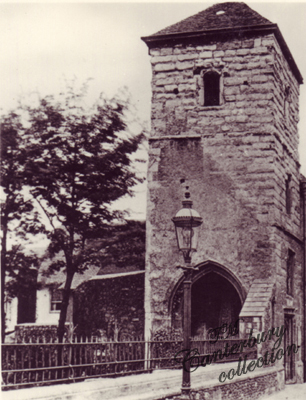
"I. Christopher Elcok, draper, 1492, S.A., p. 239 Introd., p. 239 (det.)
II. Margt. Elcok, 1494, N.
Inscrs. III. Joan, dau. of John Hacche, and w. of Hen. Lynde, of Canterbury, 1417, eff. lost
IV. Frag. of marg. inscr."

....the gown is usually worn more open in front, and openings are sometimes inserted half-way up the sleeves, as at Mickleham, Surrey, 1514; Aldenham, Herts., c. 1520; Euston, Suffolk, c. 1520; Fordham, Camb., 1521; churches in Norwich, &c.: but the arms are seldom passed through the apertures; an instance, however, at the end of the last century may be seen at St. Mary Magdalen's, Canterbury, 1492, on the brass of Christopher Elcok, Draper.*
A manual of monumental brasses 1861
*In the manuscripts written at the end of the fifteenth century, as in the illustrations to Froissart c. 1460-1480, see supra, p. cxcvi. note a, similar sleeves are frequently delineated. The gown had sometimes a fur cape to it, which is very rarely seen on brasses, as at Berkeley, Glouchestershire, 1526.
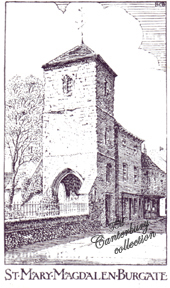
"St. Mary Magdalen's Church is situated on the south side of Burgate street and consists of a nave and south aisle, divided by square columns; at the west end is a square tower, built in 1503, containing five bells. It is a very ancient church, and belonged to the convent of St. Augustine; an octangular Norman font still remains, but like many others in the city, has a Wedgewood basin inside. Towards the building of the tower, one Sir Harry Ramsey gave six seams of lime. The interior appears to have participated largely in the advantages of the modern renovater, the paint brush, which is seen on a well soaked font, and an incongruous medley, which spreads itself all over the church. The living is a rectory, in the patronage of the Dean and Chapter of Canterbury, and was united to the living of St. George's in 1681."
Directory 1847
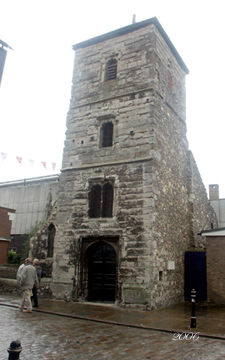
My photograph of the tower from Burgate Street
"Beyond this, again on the left hand, is the tower (built in 1503) of the church of St. Mary Magdalene, the body of which was pulled down in 1872; some of the old monumental tablets, and an octagonal font, stand under the tower."
"Canterbury; A history of the ancient city"
1870 The taking down of St. Mary Magdalene and building a new aisle in St. George the Martyr
April 26, 1829, George Stephen ASH was buried in St. Mary Magdalen.
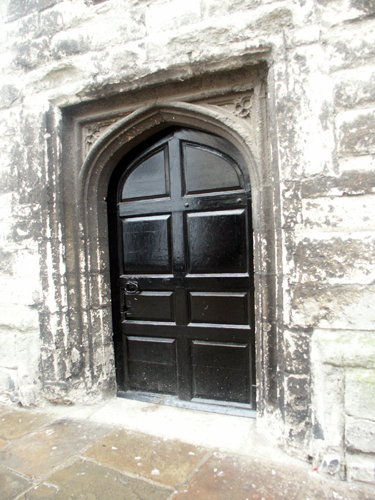
"In Burgate Street. The body of this church was taken down some years ago when the Norman font and it's 16th century brasses disappeared. Only the square tower built in 1503 now remains. The Rev. R.H. Barham*, the author of the Ingoldsby Legends, was born here in this parish."
"Handbook for Canterbury," British Association for the advancement of Science, Dover 1899 *born December 6th, 1788, at 61 Burgate, Canterbury
The Tower of St. Mary Magdalene Burgate
The church was demolished in 1871 and the baroque monument of the Whitfield family dated from about 1680 was then placed in its present position. The sculpture is of Flemish influence and is typical of the style of Arnold Quellin and Grinling Gibbons. The monument has been restored by the Victoria and Albert Museum and with the assistance of the Department of the Environment and Canterbury City Council. May 1977 From a plaque on the tower
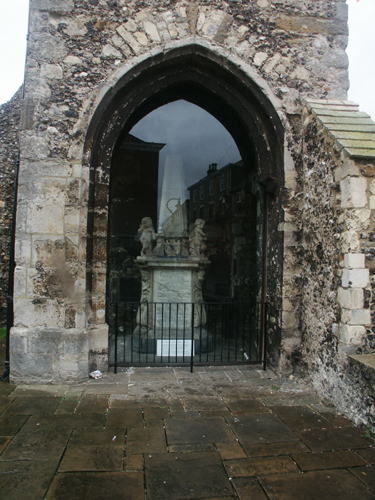
August 13, 1870 - St. George's Church, Canterbury. The legal notice that a faculty has been applied for to close St. Mary Magdalen Church, and enlarge that of St. George the Martyr, has been affixed to the church doors in Canterbury. It is proposed to take down Burgate Church, excepting the tower, in which will be preserved the monuments now in the church. The organ, bells, and fittings of the church will be sold, and the proceeds given to the fund for enlarging St. George's Church. A part of the St. George's rectory-house will have to be pulled down to make room for the new aisle. The Architect
Click on the links below for a larger view

"In St. Mary Magdalen's Church is a sumptuous monument in memory of John Whitfield, Gent. a liberal benefactor to the poor of this city: he died in 1691."
Topographical, Historical, Descriptive, and Literary, Delineation's in Kent, E.W. Brayley, October, 1807
 __
__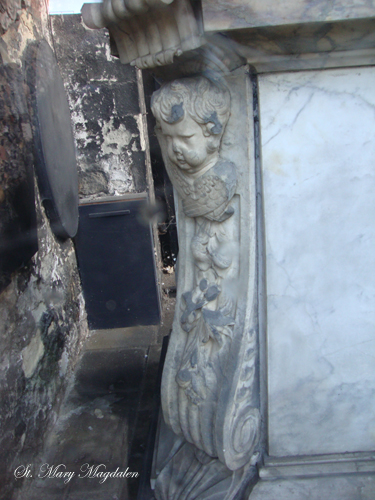
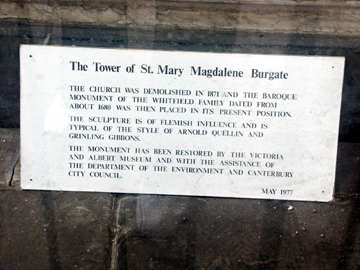
The Tower of St. Mary Magdalene Burgate
The church was demolished in 1871 and the baroque monument of the Whitfield family dated from about 1860 was then placed in it's present position.
The sculpture is of Flemish influence and is typical of the style of Arnold Quellin and Grinling Gibbons.
The monument has been restored by the Victoria and Albert Museum and with the assistance of the Department of the Environment and Canterbury City Council.
May 1977
![]()
1622 - John Manwaring was buried at St. Mary Magdalen
1692 - The purchase of a fire engine from the will of John Whitfield
1764 - list of deaths for 1764, Rev. Mr. FORSTER, Rector of St. George, and St. Mary Magdalen, Canterbury, and one of the six preachers in that Cathedral
1764 Ecclesiastical Preferments - Fra. GREGORY - St. George's and St.
Mary Magdalen's R. annexed, Canterbury
1828 - Ecclesiastical Preferments - Rev. G. Pellew, St. George R. with St. Mary Magdalen, Canterbury
"Births, Sept. 19, in the Precincts, Canterbury, the wife of the Rev. W. S. Harris Braham, a daughter." The Gentlemen's Magazine 1830
1840 - Rev. W. S. H. Braham, M.A., to the Rectories of St. George and St. Mary Magdalen, Canterbury
1843 - Rev. W. S. H. Braham
1843 Rev. W. S. Harris BRAHAM, Rector of St. George the Martyr, with St. Mary Magdalen, Canterbury, and Minor Canon of the Cathedral, to be Domestic Chaplin to the Earl of Waldegrave.
1843 - of daughters - The lady of Rev. W. S. H. BRAHAM, St. George the Martyr w. St. Mary Magdalen, Canterbury
1847 - Rev. William Spencer Harris Braham
1858 - Rev. R.G. Peter
They took down the church in 1870/71 and built a new aisle in the church of St. George the Martyr, Canterbury.
Index of Wills
John PHILCOX, cordwyner, St. Mary Magdalen, Canterbury, 1653, folio 124
Noah LEEDS, taylor, St. Mary Magdalen, Canterbury, 1655, folio 93
*Phillip GIBBON of St. Mary Magdalen, Canterbury, yeoman, in his will, proved at Canterbury 16 September 1629, mentions Mary, my daughter, wife of Thomas SHEAFE - Elizabeth, Margaret, Dorothy, and Mary SHEAFE, my grandchildren - Richard SHEAFE, my daughter Mary's eldest son - Richard SHEAFE, deceased, late grandfather of the said Richard - Gibbon SHEAFE, Son of my daughter Mary - Thomas SHEAFE, son of my daughter Mary.
